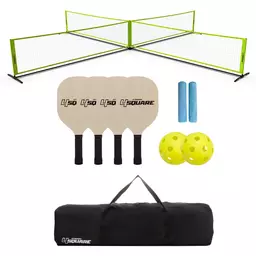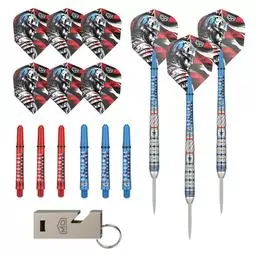Dart Basics
The most popular versions of darts consist of the same basic rules. Each play used three darts and take turns throwing the three darts at the dart board. Beyond the basic rules there are many different games, 301, 501, cricket, base ball etc. See our darts rules page for details on these games and more. There are two types of dart boards: electronic and steel tip dart boards. The games played on both types of boards generally follow the same set of rules with slight variations for what is considered a point and what is not. For an electronic board it does not mater if the darts fall out of the board after it is thrown as long as the board scores the dart. For steal tip boards, the dart only counts if it sticks in the board.
The most common question about darts is how high should the dart board be and how far should the throw line be from the dart board. The hieght is the same for both soft and steel tip boards and is 5' 8" (1.72m). The distance to the throw line is measured from the face of the dartboard. For steel tip, the distance is 7' 9 1/4" (2.37m) and the distance for soft tip is 8' (2.4384m). For more information on dart board height and throw line distance see dart board height.
DARTS
There are many shapes and size of darts. There are also several materials used to make darts.
Brass Darts - This is the least expensive type of darts. Brass is a fairly dense metal, is relatively inexpensive, and is easy to handle. Unfortunately, it is so soft that the machined "grip" may quickly dull and wear down, changing the feel of the darts. Also, since brass darts are commonly mass-produced, the quality and consistency of the machining may vary considerably. Brass darts are often used as house darts in many bars and taverns to keep the costs down.
Nickel/Silver Darts - Like Brass, this is a fairly dense metal, is relatively inexpensive, and is easy to machine. However, Nickel/Silver is harder and therefore more durable, which prevents the machined grip from wearing away as rapidly. Otherwise, similar to brass darts, and is a great choice for beginner darters on a budget.
Tungsten Darts - Tungsten is an extremely dense metal, heavier than lead. It is also very durable, so a high-density tungsten dart resists wear and the grip will last much longer. On softer metal darts, the grooves and rough knurling may wear down fairly quickly from skin acid, friction, and hitting other darts. Originally tungsten was only a small percentage of the dart barrel (40 - 50%), today most tungsten darts are between 80 and 95% tungsten.
Nickel/Tungsten darts are made of a high-tech material composed of Tungsten particles bound together with Nickel. They are more dense than Brass or Nickel/Silver darts. This means smaller diameter barrel, better "feel", and tighter possible groups on the dartboard. Tungsten is also a very durable material, and the machined grip will not wear down as quickly as on Brass or Nickel/Silver darts.
Discount outlets and other online stores often sell low-density Tungsten darts without specifying the percentage of Tungsten content, but just say "Tungsten darts". Such darts are often cheap imports and are not very good quality. Look for the percentage of tungsten - a higher number means that the darts are more dense, and generally better quality.
DARTBOARDS
Both steel tip and soft tip dart boards are layed out the same way. Both consist of 20 pie shaped segments and one cicular segment in the middle called the bulls eye. The bulls eye normally has a smaller cicular segment in the middle callded the double bulls eye. The pie shap segments are broke into 4 sections, two single segents seperated by an inner triple ring and an outer double ring.

Steel tip dartboards are made of natural rope fiber called sisal. The fibers are compressed under pressure and banded together with steel, then bonded to a non-warping backboard. The surface is then sanded and screenprinted with the intended design. Finally, the wires are stapled on the number ring and placed on with clips to allow for easy rotation in case of warn areas.
Protect Your Walls
Darts won't always hit a bristle or electronic dart board, so you'll want to place the board on a backboard or inside a cabinet to protect the walls. Consult the dart board user manual for information on what hardware is needed to hang the unit.
To decrease the chance of injury, it's wise to avoid placing the dart board in high-traffic areas. Darts can bounce 8 feet or farther, so make sure nothing breakable is within 2 to 3 feet from either side of the board. An area 5-feet wide and 11-feet long is the minimum suggested playing space.
Dart Board Height
There are numerous dart board regulations - one of which is dart board height. Height of a dart board is 5 feet, 8 inches from the floor to the center of the bullseye. Dartboard measurements should be easy to determine. Hanging dartboards is easy for quality dartboards that are hung from the center. Dart boards that hang from the top will need to be measured from the center of the bullseye to the hanger.
The type of floor in the playing area is important. A concrete, stone, or tile floor will break darts or dull the dart points. Steel-tip darts can poke holes in a wood, linoleum, or vinyl floor. Carpet will show wear from continuous dart play. A dart mat can protect the floor.

SHAFTS
Plastic Shafts - Inexpensive, and available in many colors, but break fairly easily. Good shafts until you start throwing tight groups and breaking lots of shafts. Materials are usually polycarbonate or nylon, some have replaceable tops for greater longevity.
Composite Shafts - Composite type shafts, like the Alamo or Quiver, have plastic bases that thread into the darts, combined with aluminum or other metal alloy tops that hold the flight. These are excellent shafts, quite durable, and will not vibrate loose as easily as solid aluminum shafts. Generally available with replaceable tops for economy and convenience.
Solid Aluminum Shafts - More rigid and durable than Plastic or Composite shafts, in many styles, some with decorative engraved stripes, spirals, etc. They may tend to vibrate loose, especially on heavier darts. When used with thick flights, such as Dimplex or Nylon, the slots may need to be pried open slightly, with a dart tool or knife blade. Will normally bend instead of breaking when hit; just straighten for more use.
Aluminum shafts often vibrate loose when playing, so rubber O-ring lock washers are highly recommended. This only occurs when there is a metal-to-metal contact, so plastic shafts do not normally need the lock washers.
Spinning Shafts- A variety of shaft styles are now available, that allow the flights to turn out of the way when struck by another dart. Spinning shafts do nothing to improve the flight of the dart through the air, but they do allow tighter groups by letting the flights align with each other. Also, these shafts will greatly reduce torn flights.
FLIGHTS
Hard Flights - made of a stiff polyester plastic that holds shape well. The layers are permanently sealed together by heat during manufacturing. Because the plastic is harder, they don't tear as easily as Soft flights... however if they do tear, they cannot be resealed and are ruined. Hard flights do not flex like Soft flights when hit, but do "pop off" the shaft when hitting another dart. This is desirable as it reduces deflection and allows tight groups. Hard flights were originally made of a clear plastic, which resulted in fairly dull colors in printed designs. During the last few years, Melinex, a type of opaque plastic, has been used for printing hundreds of brighter designs.
Nylon Flights - made of ripstop nylon fabric, ar by far the most durable type of flights. These dart flights are are very hard to tear. The stiffness varies according to the weight and type of fabric used by the manufacturer, but is roughly midway between Soft and Hard flights. The most common point of wear with this flight is at the front, where it is inserted into the shaft. Since ripstop nylon fabric is a thicker material, it is important to pry open the slots on the shaft for a properly loose fit to avoid damage to the flight. Nylon flights are extremely common and available in thousands of differents designs.
Dimplex Flights - and other similar styles are actually hard flights which have been embossed with a texture. The bumpy or ribbed surface tends to stiffen the flight, which some darters consider desirable. The extra surface area also adds a small amount of drag to the flight, which makes the dart slightly more stable in some cases. The various embossed types of flights are generally a little harder to insert into a metal shaft, due to increased thickness. Use a dart tool or knife blade to gently spread open the slots at the back of the shaft.
Flight Protectors - are small metal or plastic devices that fit over and protect this area. The life of a set of flights may be greatly extended by using Flight Protectors. They are also reusable and may outlast many sets of flights.
Soft Flights - are made of a flexible plastic sheet, preprinted with a variety of designs and then folded into shape. Adhesive (glue) holds the layers of plastic together. If the flight is torn during use, the layers can be pressed together with fingers and the adhesive will "heal" the tear. Another benefit of this type of flight is that a Soft Flight will often flex out of the way if another dart hits it. These flights are available in hundreds of bright, attractive designs. Also known as "Reseal Flights".
TIPS
Steel Tip - You have two options with steel tip darts. Fixed point or a moveable point. A fixed point is when the point is fixed into the dart and it does not move. This is the most common type of dart. Moveable points move. They are designed to help decrease the chance of bounce-outs.
Soft Tip - Unlike steel tip, the difference is in the width of the opening of the barrel, not the action of the point. You have two choices here, either 1/4" or 2BA. 1/4" is the wider of the two choices. 2BA is much narrower and is much more common.


